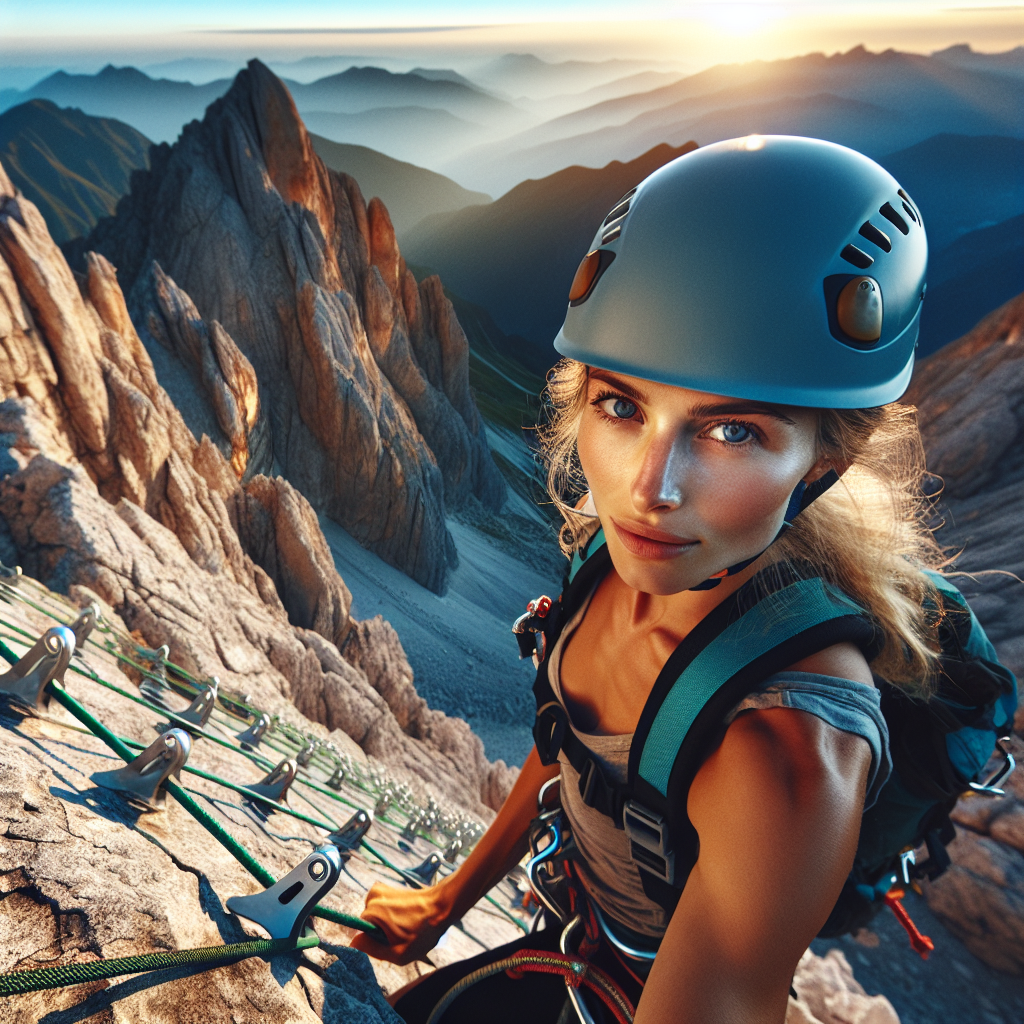Imagine standing at the foot of a magnificent mountain, its peak lost in the clouds, the prospect of reaching the top feeling as distant as a dream. That might just become your reality. The Complete Guide to Via Ferrata: Climbing for All equips you with all you need to embark on this adventurous journey. Appreciate the allure of mountain climbing without the technical complexities as you navigate steep cliffs and rocky terrain with secured cables and sturdy iron rungs. Regardless of your fitness level or hiking expertise, this guide ensures that the breath-taking beauty of the mountain summits is accessible to all. So brace yourself, because the heights are waiting for you!
Understanding the Concept of Via Ferrata
Climbing might seem like a tough feat reserved for the experienced mountaineers among us. The ropes, the gear, the perilous heights – it all seems to be a bit overwhelming. But have you ever heard of Via Ferrata? Well, don’t worry if you haven’t; we’re here to outline it all for you!
Origins and history of Via Ferrata
The concept of Via Ferrata is steeped in history. Originally developed in the Dolomite mountain region of Italy during the First World War, they were primarily meant to aid the movement of personnel over difficult terrain. By attaching iron ladders and cables to the rock surfaces, soldiers could traverse steep mountainous paths that would otherwise be treacherous. Today, these routes have evolved into recreational climbing routes, keeping the thrill and adventure alive for outdoor enthusiasts.
What exactly is Via Ferrata?
In Italian, Via Ferrata translates to “Iron Path,” which accurately sums up the concept. It’s a secure climbing route, embedded with iron steps, ladders, and bridges, equipped with a steel cable which runs along the entirety of the route. The beauty of it? You, the climber, remain securely attached to this cable at all times, allowing for a relatively safe climbing experience.
Different types of Via Ferrata routes
No two Via Ferrata routes are the same. While some are more beginner-friendly, others challenge even experienced climbers. The difficulty of a route can depend on several factors such as the steepness of the path, the type of target terrain, and the climatic conditions of the region.
Essential Gear for Via Ferrata
Safety and preparedness are paramount for any form of climbing, and Via Ferrata is no exception.
Importance of the right gear
The correct gear not only ensures your safety but also enhances your overall climbing experience. From maintaining a firm grip on iron rungs to protecting you from rocky terrain, every piece of your gear has a function.
Necessary equipment and clothing
For a full Via Ferrata adventure, you would require a climbing harness, a Via Ferrata kit with carabiners, a helmet, gloves, proper hiking footwear, and suitable clothing adaptable to weather conditions.
Recommendations for brands and stores
There are several trusted brands such as Petzl, Black Diamond, and Mammut known for their climbing gear quality. And while buying gear, consider stores that cater specifically to climbing or outdoor sports for expert guidance!

Safety Guidelines for Via Ferrata
Safety, Safety, Safety – We can’t stress this enough.
Understanding safety protocols
Safety protocols for Via Ferrata include understanding how to use your equipment correctly, being aware of your surroundings, and respecting the rules and regulations set up for the route.
How to secure yourself
Securing yourself means to always ensure you are hooked onto the safety cable. Even when moving, one carabiner should stay attached at all times, providing constant security.
What to do in case of an emergency
In case of an accident or sudden illness, immediately alert the local rescue services. It’s helpful to have a basic knowledge of first aid and to carry a first aid kit.
Learning the Technical Skills for Via Ferrata
While Via Ferrata might not require the technical prowess of traditional rock climbing, it has its own set of essential skills.
Basic skills required
The essential skills involve knowing how to properly use your Via Ferrata kit, navigate the iron rungs and ladders and manage your endurance and strength throughout the climb.
Advance climbing techniques
While the basics will get you started, refining your techniques like optimizing movements for energy efficiency, understanding body positions to increase reach, and learning to rest properly on the path can help make you a proficient Via Ferrata climber.
Tips and tricks for quick learning
Joining a climbing group or hiring a guide can provide helpful insights. Spending time on physical conditioning and mental preparedness can also aid in quick learning.

Training for Via Ferrata
A physically and mentally demanding activity, Via Ferrata does require a measure of training.
Creating a training plan
A balanced regimen that works on both your stamina and your strength is key. Start with basic cardio and strength training exercises, gradually increasing intensity according to your comfort level.
Exercises for strengthening relevant muscles
Focus on conditioning the muscles used most during climbing- your arms, upper body, and legs. Pull-ups, push-ups, squats, and lunges are all great exercises to target these muscles.
Mental training for Via Ferrata
Just as your body needs to be strong to face Via Ferrata, so does your mind. Practicing mindfulness can help you manage fear and anxiety, increasing your concentration and overall enjoyment of the climb.
Selecting a Via Ferrata Route
Choosing the right route could be the difference between a pleasant experience and an intimidating one.
Factors to consider when choosing a route
Consider your fitness level, previous climbing experience, and the current weather conditions when picking a route.
Top Via Ferrata routes worldwide
From the rocky faces of Italian Dolomites to the Canadian Rockies, Via Ferrata routes exist worldwide – each offering a unique climbing experience and breathtaking views.
How to analyze a Via Ferrata route map
Understanding how to read the grade and symbols on the map is crucial. It will give you an idea of the route’s duration, difficulty, and specific features to be aware of.
Understanding Weather Conditions and Risks
The weather has a significant role to play when planning your Via Ferrata adventure.
Role of weather in Via Ferrata
From dictating the gear you’ll need to wear to the maintenance of the Via Ferrata route itself, the weather can impact many aspects of your climbing experience.
Risks linked to adverse weather conditions
Adverse weather, such as heavy rain, snow, or strong winds, can turn an otherwise safe Via Ferrata route into a risk-filled endeavor. So, paying attention to the forecast is crucial.
Safety measures for different weather scenarios
Ensure to have the adequate gear and equipment to adapt to changes in weather, and consider postponing your climb if the weather becomes too harsh.
Benefits of Via Ferrata
Along with the adrenaline surge, Via Ferrata also offers numerous benefits.
Health and fitness benefits
Climbing exercises multiple muscle groups, increasing strength, and improving cardio health. It’s a full-body workout in the open air!
Mental and emotional benefits
The sense of achievement when reaching the top, the focus needed during the climb, and the way it forces you outside of your comfort zone – Via Ferrata can help improve your mental agility and emotional resilience.
Social and environmental benefits
It encourages teamwork and camaraderie among climbers and can also foster a deep appreciation for the natural environment.
Accessible Climbing: Via Ferrata for All
Via Ferrata is a climbing discipline that opens the mountain world to just about everyone!
Via Ferrata for children
Equipped with proper gear and under adult supervision, children can safely enjoy Via Ferrata, develop physical strength, and learn about the beauty of nature.
Via Ferrata for the elderly
With a range of routes varying in difficulty, even seniors can partake in the climb. It’s never too late to begin an adventure!
Via Ferrata for differently-abled climbers
Customized gear and routes make it possible for differently-abled climbers to experience the joy and thrill of climbing. Every achievement on the Via Ferrata route is a victory.
Future of Via Ferrata
As climbing continues to grow in popularity, the future of Via Ferrata is bright.
Emerging trends
With more and more people seeking outdoor adventure activities, there is a rising trend in the establishment of new Via Ferrata routes worldwide.
Impact of sustainability and climate change
The climbing community has become increasingly aware of their environmental impact, leading to sustainable practices like using environmentally friendly gear and conducting regular maintenance of routes.
Developments in Via Ferrata gear technology
Advancements in technology and design will continue improving the safety and efficiency of Via Ferrata gear, making the experience even more secure and enjoyable.
Embarking on a Via Ferrata journey can indeed be an exhilarating experience! So grab your gear, pick a beautiful route, and give yourself a chance to experience a unique adventure up high. With the right preparation and mindset, the iron path awaits your exploration!

